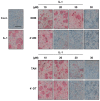Polymethoxyflavones and Bone Metabolism
- PMID: 40077692
- PMCID: PMC11901578
- DOI: 10.3390/nu17050822
Polymethoxyflavones and Bone Metabolism
Abstract
Phytochemicals, such as flavonoids, are bioactive compounds produced by plants, including citrus fruits, that exhibit antioxidant effects on mammalian cells and tissues. Polymethoxyflavones (PMFs) are a family of flavonoids found in the pulp and peel of citrus fruits, and have been reported to have potent antioxidant activity implicated in the prevention of human diseases. Several studies have shown that PMFs have a protective effect on bone resorption in mouse models of diseases, including osteoporosis, rheumatoid arthritis, and periodontal disease. PMFs significantly suppressed the differentiation of osteoclasts (bone resorptive cells) through indirect and direct mechanisms. The indirect effect of PMFs is the suppression of inflammatory mediator production, such as prostaglandin E2 (PGE2), and the reduction of osteoclastic inducers, such as the receptor activator of NF-κB ligand (RANKL), in osteoblasts (bone-forming cells). The direct effect of PMF suppresses osteoclast differentiation and function by inhibiting the NF-κB signaling pathway. In silico molecular docking studies indicated that PMFs target the ATP-binding pocket of IKKβ and inhibit the NF-κB signaling pathway. These findings suggest that PMFs protect against bone destruction by interfering with the NF-κB pathway in osteoblasts and osteoclasts. In this review, we summarize the latest findings regarding the effects of PMFs on various bone resorption-related diseases in mouse models.
Keywords: bone metabolism; bone resorption; osteoblast; osteoclast; polymethoxyflavone; prostaglandin E2.
Conflict of interest statement
The authors declare no conflicts of interest.
Figures





References
-
- Huang Y.-S., Ho S.-C. Polymethoxy Flavones Are Responsible for the Anti-Inflammatory Activity of Citrus Fruit Peel. Food Chem. 2010;119:868–873. doi: 10.1016/j.foodchem.2009.09.092. - DOI
Publication types
MeSH terms
Substances
Grants and funding
LinkOut - more resources
Full Text Sources

